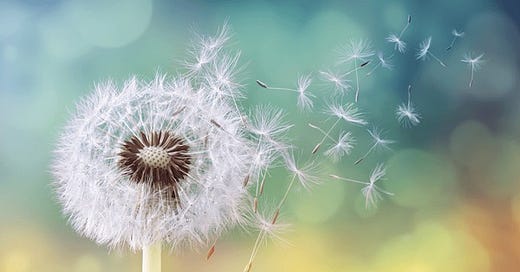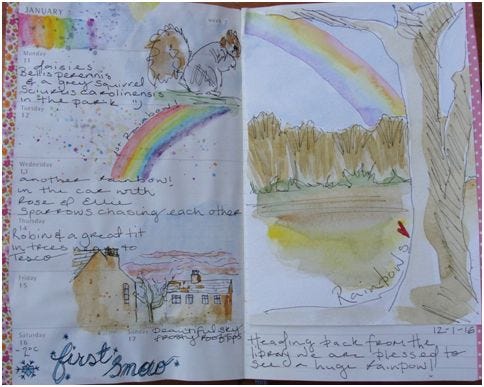Seeing the Wind(Pt. 2) Poetry Gives Voice to What's Hidden in Nature
Make the unseen come alive, drawing children into wonder through poetry and inspiring them to cherish and protect the natural world.
In Seeing the Wind: Part One, we explored a child’s need for poetic vision—how it helps them see beyond the surface—a small bird’s breath in winter can become a whisper of wonder. John Muir, shaped by poetry and Scripture, saw sequoias as living cathedrals.
Have you noticed? Some things defy measurement, weight, or definition, yet they shape our deepest experiences. The rustling of golden aspen leaves in autumn. The hush of snowfall blanketing an empty field. The rhythmic crash of waves against the shore. These moments stir something within us—but how do we capture them in words?
Poetry makes the invisible visible, turning light on water into shimmering silver and a field of flowers into a host of golden daffodils.
Teaching children to see with poetic vision, gives them more than words—it gives them a way to love the world.
A Surprising Connection that Leads to Love
Some things cannot be measured, weighed, or captured in scientific terms, yet they shape our experience of the world. The rustle of golden aspen leaves in autumn. The delicate tinkle of snow ice falling on an empty field, the rhythmic crashing of waves against the shore. These moments stir something in us—but how do we describe them?
Poetry steps in where mere description falls short.
Consider Joyce Kilmer’s famous first line from Trees:
“I think that I shall never see
A poem lovely as a tree.”
What is Kilmer telling us? A tree, though physical and rooted, is also a living poem—full of movement, strength, and quiet wisdom. In these simple lines, we don’t just see a tree—we feel its presence in a certain way.
Or think of our national anthem’s imagery:
“From sea to shining sea.”
Here, a vast and varied land is made tangible in just a few words, shimmering with expansiveness and light.
Or William Wordsworth’s unforgettable image from I Wandered Lonely as a Cloud:
“A host of golden daffodils.”
Not just many daffodils, but a host—a gathering, a presence, almost a choir of flowers singing their bright song to the wind. Wordsworth takes something as ordinary as a field of flowers and turns it into something luminous, something eternal.
Children Are Naturally Poetic
Before they are taught otherwise, they describe the world in ways that brim with wonder. A child does not just see raindrops; they see “sky tears.” The wind is not just blowing; it is “whispering secrets through the trees.” Their minds grasp intuitively what poetry seeks to express—that nature is alive with meaning, and language can give it shape.
How do we nurture this inborn poetic vision?
1. Read Poetry Aloud in Nature
Just as Muir sat at his father’s knee listening to poetry, we can do the same for our children. Bring a small poetry book on a nature walk. Sit beneath a tree and read Kilmer’s poem about trees. Near a river, read Robert Frost’s Stopping by Woods on a Snowy Evening. Let the words settle into their hearts as they look around and see the living reflections of poetry in the landscape.
A book to enjoy is "Sing a Song of Seasons: A Nature Poem for Each Day of the Year" edited by Fiona Waters and illustrated by Frann Preston-Gannon.
2. Encourage Poetic Naming
After a walk outdoors, ask children to describe what they saw—but challenge them to use the most beautiful or unusual words they can think of. Instead of “big tree,” could they say “towering green giant”? Instead of “blue sky,” what about “a sea of soft sapphire”?
3. Write a Nature Haiku
A haiku is short, simple, and captures a moment in time. Try this format:
Five syllables
Seven syllables
Five syllables
Example:
Golden leaves drift down
Whispering their final goodbyes
To the waiting earth.
This tiny exercise sharpens observation and nurtures appreciation.
Here is a haiku by the renowned Japanese poet Matsuo Bashō (1644–1694):
An old silent pond...
A frog jumps into the pond—
Splash! Silence again.
This haiku captures a fleeting moment in nature with simplicity and depth, evoking both stillness and movement, sound and silence. Bashō's poetry often reflects a deep connection to the natural world, encouraging us to pause and notice the beauty in small, ordinary moments.
4. Enjoy Nature Poetry with Art
Have children illustrate a poem—either their own or a famous one. Let them bring words to life through color, movement, and texture. This combination deepens their connection to both the poem and the natural world.
Poetry Leads Children to Preserve and Protect
By teaching children to see poetically, we are giving them a lifelong gift. They will move through the world with more grace, more wonder, and a deeper sense of connection with the natural world.
They will learn to cherish what is fragile, to delight in the unnoticed, to recognize that even in the simplest things—the turning of a leaf, the call of a bird, the whisper of the wind—there is poetry waiting to be found.
And perhaps, like Muir, this poetic vision will one day call them to preserve and protect the world they have come to love.
Let us give them words. Let us give them wonder. Let us teach them to see the wind.
What’s Next? Spring Green!
Spring is only a few weeks away in Michigan. It is a season of endless discovery! In my next post we’ll jump into awakening children’s senses—guiding them to see, hear, and feel the earth’s often riotus return.
See you next Sunday!
🦋Tell us your favorite nature poem or activity by clicking the button below.🦋
I am grateful for your company on this journey.
Sheila Carroll
Nature Study Companion
Nature Study Store





